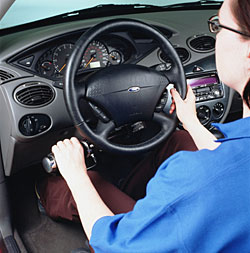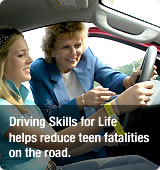by Bill Gray

Hand controls on a mobility tuned Ford.
Click for more on Mobility Motoring.
DEARBORN, Nov. 30, 2007 -- Carol Hollfelder hasn't walked in 20 years. But when she gets behind the wheel of one of her seven Mustangs -- including the supercharged pony car she races on the SCAA pro circuit --she's off and running.
"Independence for Americans with disabilities like Carol starts with the freedom to get where they're going," says Kathy LaPointe, Ford Mobility Motoring manager, Commercial Truck Sales and Marketing. LaPointe has the best-of-both-worlds job of serving consumers with disabilities and selling them on the Ford brand, the No. 1 nameplate in the mobility segment with a 24 percent market share.
"It's the most rewarding job I've ever had, and I'm proud that the company is committed to improving the lives of these customers," she said.
The Ford Mobility Motoring Program provides up to $1,000 towards the cost of adaptive equipment.
Hollfelder was just 18 when a motorcycle crash paralyzed her from the waist down and ended her budding equestrian career. So she merely switched her born-to-run ambitions from horses to horsepower.
Now, a six-on-the-column stick shift with a computerized clutch on the floor provides her the equalizer on the track, and her next goal is to tag team the 24 Hours of Daytona endurance classic with her racecar-driving husband, Paul.
And when she's out and about, doing more mundane tasks like picking up the groceries, she merely breaks down her lightweight fold-up wheelchair, tosses it into the backseat, and her Mustang is gone in 60 seconds.
The personalized license plate may read "DONT WALK," but the driver attitude inside the cockpit is "NO BIG DEAL."
That's the main message people with disabilities are trying to get across to the general population, which still harbors stereotypes that they are sub-performers, both physically and mentally. For instance, Hollfelder still prompts a lot of double takes when she's getting in or out of her car.
"There's still a very basic belief that if you can't walk, you can't drive either," she says. "It's a huge revelation for most people to find out that a disabled person can get into a vehicle by herself, let alone get into something cool like a Mustang."
Experts agree, saying they're still working toward the day when a television crew can film a crowd of people outside their cars and have nobody notice that one of them is in a wheelchair. They refer to this goal as the "integration" of people with disabilities into the mainstream psyche.
"To tell you the truth, it's a hard stereotype for our society to get over," said Dr. Glen House, director of Penrose Hospital's Center for Neuro and Trauma Rehabilitation Center in Colorado Springs, Colo., and co-founder of Disaboom.com, a new lifestyle Web magazine for people with disabilities. "I sometimes catch myself talking to the family instead of the patient during consultations, until I realize the patient is nodding at me real hard, signaling, 'I'm hearing you, talk to me.' And I'm a quadriplegic myself."
House, who doesn't have use of his legs or fingers, drives a Ford F-150 with a Bruno lift stored in the truckbed. The lift swings out and lifts him into the cab, and he then uses hand controls on the steering wheel to drive.
The 38-year-old House chose the F-150 partly for self-image and partly because he is a pragmatist and Colorado Springs gets a lot of snow.
After a skiing accident left him paralyzed 18 years ago, "they put me in a van, which, you know, was fine for mobility, but when you're 20 you want something a little sexier, and I wanted a truck -- it's just more me."
This attitude is reflected in the changing trends in the mobility segment. While the Ford E-Van series has been the dominant vehicle of choice for people with disabilities for years, other vehicles are starting to gain ground as new assist technologies open up an array of transportation options.
Today, there are joystick-like steering devices and voice-command systems that switch on wipers and turn signals. And vehicle seats can be customized to electronically turn to allow drivers an almost seamless transition from wheelchair to behind-the-wheel.
"If people don't have the use of their legs, but have good upper body strength, they can usually get away with hand controls and a transfer seat," said Bill Reed, manager, Ford Special Vehicle Engineering.
The E-Series is still the most adaptable vehicle, Reed says, because it covers virtually any possible wheelchair configuration. And while Ford itself doesn't upfit vehicles for people with disabilities, Reed's department works with the hundreds of aftermarket customizers who do and runs a quality process assessment program that rates them.
What the Ford team is finding is that the aftermarket technology powered by expanding revenue potential is pushing the state-of-the-art higher every day.
Even the venerable wheelchair itself has gone high-tech. There are now versions made from lightweight yet tough materials like titanium, which allow the Carol Hollfelders to casually toss them into the backseat with the ease of buckling a safety belt. And there are even chairs that can go over curbs while keeping their occupants secured.
All this technology has been driven as much by the booming growth of the segment as by the good will of those providing it.
The market segment that encompasses people with disabilities is far too large to be called a niche -- there are some 22 million Americans living in a third of all U.S. households who have some form of physical disability. This includes 42 percent of women and 38 percent of men age 65 and older, numbers that will surely grow even larger as the 78 million baby boomers are now entering their 60s.
Reaching this booming segment is a key objective for Ford Mobility's LaPointe and her team.
"We've done a million things -- from trade shows to ads in Motor Trend to sponsoring athletic events -- we've even given away an E-Series van through the 'Live with Regis and Kelly' show," she said.
Now, Ford is part of a big effort to reach this segment in a new, more effective way.
Last month, the company became a charter sponsor of House's Web site, Disaboom.com, which aspires to be the definitive service and lifestyle information source for this audience, covering everything from health advice to matchmaking tips. Its goal is to attract more than a million monthly visitors by the end of February, and Howard Lieber, vice president, Disaboom.com marketing says they're already ahead of that plan.
"The reason it's caught on so quickly is its general tone and manner," says Lieber. "We're telling our readers that people with disabilities aren't limited to what they want to achieve in life, they just have to make some adjustments."
Just like Hollfelder has, "adjusting" her way right into the winner's circle.

